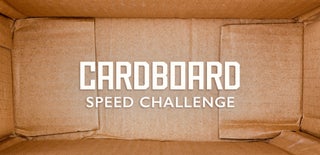Introduction: Cardboard Keypad
I needed a numerical keyboard for another project but it would take too
long until I buy and receive a keypad at home. So I thought about making mine with what I had here - milk carton, aluminum foil and double sided adhesive tape. It won't be beautiful but aftwards you can print a keypad layout and glue on it.
Supplies
- Thin cardboard;
- Aluminum foil;
- Adhesive tape;
- 8 thin wires;
- Pencil;
- Scisors.
Step 1:
The fisrt thing we need is to define the size of the matrix we are going to use for the keypad.
In this case I have used 4x4. Then we have to cut a piece of the carton and mark the places of the keys. I have marked with a pen where the keys I'm going to use will be.
Afterwards, with the knife, I've cut the places where the keys will be from the center, then with the scisors I've enlarged them until the desired key size.
At the pictures is shown how the matrix is supposed to look like when finished, I did it this size but everyone does it as preffered.
Step 2:
We have to take another piece of the milk carton. I took this right in the fold so it is easier. Placed the matrix there and marked the keys on the right side, then mirroring the matrix, marked the left side.
Afterwards we are going to need these markings to be well aligned and over them the aluminum strips will be placed.
On the aluminum foil we have to make the same markings we've made on the carton. The piece of aluminum must be bigger than the matrix because we need it also for the terminals. It is not possible to draw with the pencil on the foil, perhaps a little, but it marks, what is enough so we will mark the keys as made with the carton. This must be done for two pieces of foil, one for the lines, and the other for the columns of the matrix..
Step 3:
After that, we use the double sided tape, cut it and paste the strips on the markings we did before. Columns on the right side and lines on the left side.
We need to cut it on strips right over the marking of the rectangles of the keys, remembering that the lenght of the strip must excced the size of the matrix since we will use for making the terminals.
And we have two aluminum foils with the same markings, one will be cut as columns and the other as lines,
also following the lines of the rectangles of the keys.
When everything is cut, we start to paste them on the keypad.
We remove the tape cover and it is now very importante that the rectangular markings on the foil be well aligned to the pen markings on the keypad so it can work perfectly.
Step 4:
There is something different on how to paste the lines. Before pasting them, we need to cut thin foil strips to be placed between the columns and it has to excced a bit at the top.
So we paste it there (between the column) and then paste the line over it and fold the excceding piece.
In order to this thin strip not to make contact with the line, I have covered it with tape between the rectangles of the line below, so it will be isolated an I can paste the next line over it, contactless.
We have to do it for all the lines: place the thin strip, paste the line over it and isolate for the next lines.
The pictures show how it should look like when all the lines and columns are properly placed.
And of course, test it with a multimeter to check for short circuits between the lines.
Step 5:
For the terminals, a small piece of foil was used.
The inner wires was separated on half, and wraped with the aluminum foil, that will be in contact with the strips of the keypad.
The same thing was done with all the 8 wires we need and at the other side I have put a bit of solder because the wires are too thin, so they will be more resistant and easier to connect to the breadboard.
Now, put the terminals with the wire below the aluminum strips and paste then with tape. Now each wire is connected to a conductive strip. Close the keypad and now, when you press a key, a column will make contact with a line. This is how a matrix keypad work. Now you only need to connect it to your circuit. On the video I used Arduino with library Keypad.h.
https://playground.arduino.cc/Main/KeypadTutorial/

Participated in the
Cardboard Speed Challenge








